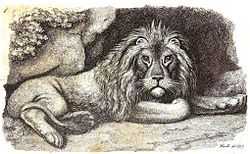Samuel Howitt

Samuel Howitt (1756/7 – 1822)[1] was an English painter, illustrator and etcher of animals, hunting, horse-racing and landscape scenes. He worked in both oils and watercolors.
Life and work


Howitt was a member of an old Nottinghamshire quaker family. In early life he lived at Chigwell, near Epping Forest, Essex, was financially independent and devoted himself to field sports. However he ran into financial difficulties and was obliged to turn to art as a profession - which up until then he had engaged in as a talented amateur.
Coming to London, he was for a time a drawing master at Samuel Goodenough's school in Ealing. In 1783, he exhibited 3 coloured drawings of hunting subjects with the Society of British Artists. From time to time he also exhibited at the Royal Academy, London: in 1784, a hunting piece; in 1785, 2 landscapes - "A view of the ruins of an abbey" and "Fairlop oak"; in 1793, "Jaques and the Deer" and "A Fox Hunt"; in 1794, "Smugglers alarmed"; in 1800, 2 pictures titled "Deer"; in 1814 "Dead game"; and in 1815, "Bella, horrida Bella".[2] He probably exhibited relatively little because he was so much in demand as a commercial illustrator.[3]
He worked both in oils and water-colours, confining himself to sporting subjects and illustrations of natural history, which were carefully drawn, spirited and truthful. Howitt was closely associated in his art with Thomas Rowlandson, whose sister he married, and his works did, at one time, often pass for those of his brother-in-law; but, unlike Rowlandson, he was a practical sportsman, and his scenes were more accurately composed. He was a clever and industrious etcher, and published a great number of plates similar in character to his drawings, and delicately executed with a fine needle. He also produced a number of caricatures in the manner of Rowlandson.
Howitt illustrated (Captain) Thomas Williamson's "Oriental Field Sports" (1807), based on sketches made by the author in India .[4] He also illustrated several other work: "Thoughts on Hunting" (London: D. Bremner, 1798),[5] "Miscellaneous Etchings of Animals" (50 plates, 1803); "British Field Sports" (20 coloured plates, 1807); "The Angler's Manual" (12 plates, 1808); "A New Work of Animals, principally designed from the Fables of Æsop, Gay, and Phædrus" (56 plates, 1811); "Groups of Animals" (24 plates, 1811); "The British Sportsman" (70 plates, 1812); and many of the drawings for "Foreign Field Sports" (1814).
Howitt died in Somers Town, London in 1822, and was buried in St. Pancras cemetery.
References
- ↑ Ruth Cohen, Howitt, Samuel (1756/7–1823) (ODNB - 26 July 2010).
- ↑ Gilbey, 1900.
- ↑ Gilbey, 1900, p39.
- ↑ Thomas Williamson and S. Howitt. Illustrations of Indian Field Sports (A. Constable, 1892)
- ↑ Gilbey, 1908, p38.
- Attribution
![]() This article incorporates text from a publication now in the public domain: "Howitt, Samuel". Dictionary of National Biography. London: Smith, Elder & Co. 1885–1900.
This article incorporates text from a publication now in the public domain: "Howitt, Samuel". Dictionary of National Biography. London: Smith, Elder & Co. 1885–1900.
Bibliography (selected)
Illustrated by Howitt:
- The Anglers manual (Samuel Bagster, 1808).
- British preserve, drawn and etched by Samuel Howitt (Rodwell & Martin: London, 1824) - plates depicting British fauna.
- Groups of Animals, Containing Forty-four Plates, Drawn from the Life and Etched (Edward Orme, 1811).
- Thomas Williamson and S. Howitt. Illustrations of Indian Field Sports (A. Constable, 1892)
About Howitt:
- Gilbey, Sir Walter. Animal painters of England from the year 1650, volume 2 (London : Vinton & Co., 1900) pp. 36–46.
External links
| Wikimedia Commons has media related to Samuel Howitt. |
- Biography and works of Samuel Howitt (Heatons of Tisbury)
- Samuel Howitt online (ArtCyclopedia)
- Howitt on Artnet
- The paintings of Samuel Howitt (Exhibition at Museum of Island History, Isle of Wight)
- Etchings by S. Howitt ("Art of the Print")
- Misc. etchings by Jowitt (antiquemapsandprints.com)
|